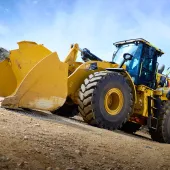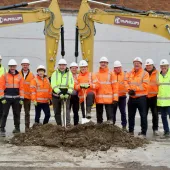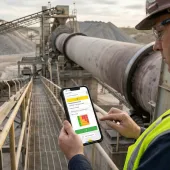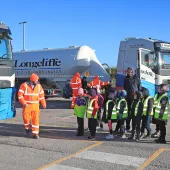Simple Tips for a Safety Culture in Load and Haul in Quarries
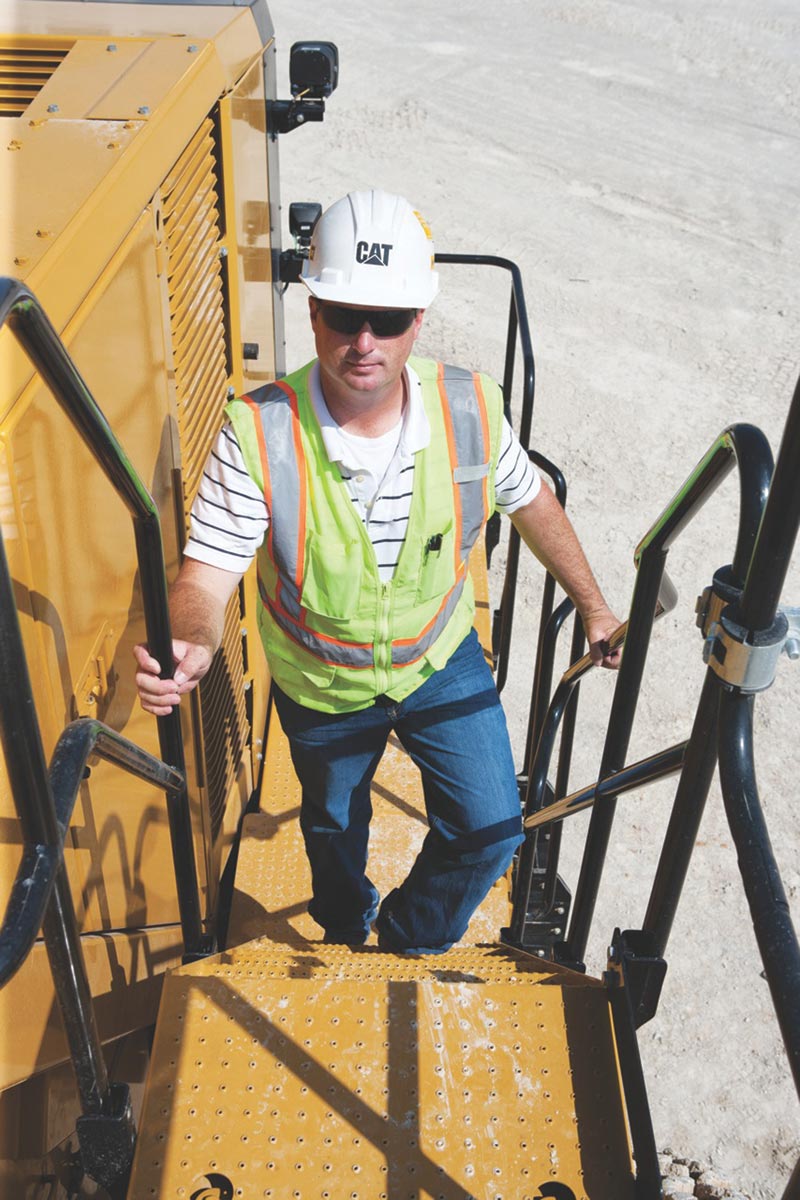
First published in the November 2013 issue of Quarry Management
Safety must be front of mind in all quarrying operations, and often simple steps can ensure a safe worksite is maintained. Alexander Robinson, quarry industry representative in global construction and infrastructure for Caterpillar Australia, revisits the importance of everyday vigilance in maintaining a safe working environment
Maintaining a safe work environment in the quarrying industry is critical. It is often simple operational issues, including inadequate walkways or scaffolding, poor housekeeping, lack of training and operator fatigue, that cause injuries. Set out below are 10 simple safety tips that may assist in avoiding safety incidents in loading and hauling.
1. Wear seat belts
Seat belts are an essential safety feature at quarry sites. It is important to remember that they hold operators in the seat and help contain them inside the roll-over protection structure (ROPS) in a collision or tip-over event, when they are used properly.
The seat assembly, which includes the seat belt and mounting hardware, should be inspected regularly as required during the pre-shift walk-around and as instructed in the manufacturer’s operation and maintenance manual.
When inspecting seat belts:
- Check the seat belt mounting hardware for wear or damage and replace any hardware that is worn or damaged. Make sure the mounting bolts are tight.
- Check the buckle for wear and for damage. If the buckle is worn or damaged, replace the seat belt.
- Inspect the seat belt for webbing that is worn or frayed and, if needed, replace the belt.
- Check the label for date of installation. It is recommended that the belt be replaced after three years of service. Consult your dealer for replacement advice and replacement components.
2. Ensure operator visibility
Lack of adequate visibility at quarry sites can be commonplace and always constitutes a serious hazard.
Factors such as difficult light conditions, fatigue, dust, dirt, wind and rain, and reversing operations or stockpile heights can cause complications in seeing other vehicles, people, haul roads and other important hazards.
If visibility is seriously compromised during a shift, operators should stop the equipment until visibility improves and contact their supervisor.
Poor visibility can lead to injury or death and damage to equipment and facilities, so it is important to keep a visual check on the job site and inform management and other operators about any unsafe conditions or visibility risk areas.
With regard to equipment, visibility risks can be reduced with good cleanliness practices. Clean windows and mirrors during breaks and inform management of any broken windows or mirrors.
Ensure the haul road and blast sites are well maintained and dampened down to reduce dust and dirt. And when completing a shift or parking the equipment, make sure it is with clear visibility of other equipment.
3. Always wear personal protective equipment
Personal protective equipment (PPE) is the first defence, designed to protect plant operators from workplace hazards. Operators should consult site safety representatives to ensure they have the required PPE for their position.
Common PPE in a quarrying environment includes a hard hat, eye protection, high-visibility vest, steel toecap safety boots, gloves, hearing protection and task-appropriate respiratory protection for which operators have been medically cleared and test-fitted.
4. Adhere to legally required site-specific training
Training ensures employees are aware of hazards and supports a ‘safety culture’ at a job site.
All applicable employees should be certified and approved, in accordance with government regulations, to be on the site.
Additionally, all employees should complete any site-specific safety courses prior to work beginning, eg fall protection and confined-spaces training.
It is always important to consult with the site safety co-ordinator for any further information and to ask questions.
5. Respect mobile equipment right of way
Quarry traffic is a danger for operators and visitors to site, so it is important to ensure all traffic and directional signs are well maintained and in good operating condition.
Employees and visitors must be trained on the proper traffic flow and abide by the rules set for the site.
For example, some sites might alternate the traffic pattern or direction from normal road traffic patterns, to allow for better visibility of safety berms and benches and to improve visibility in wet conditions.
At all times, rules for right of way determine which vehicle moves first in operating situations and this rule is often determined by site management and communicated prior to operators using the haul roads.
6. Recognize bench and highwall hazards
Bench and highwall hazard recognition is important in quarrying because the environment changes rapidly with excavation.
Employees should undertake bench and highwall hazard recognition training to identify cracking, rutting, loose ground, sloughage and large rocks. If material needs to be dumped over a berm it should be done while maintaining the safe-height working requirements.
Safety berms on haul roads and around infrastructure should be a minimum of half the wheel height of the largest piece of equipment on the site.
In daily operations it is important that changes to bench or highwall conditions are communicated to the following shift; loose material should also be identified and dealt with before performing work.
A simple, but important, load and haul rule is that loading shovels and trucks are positioned so the cabs swing away from the bench face when loading.
7. Conduct walk-around inspections
These may only take a few minutes but walk-around inspections are one of the best ways to prevent mechanical problems with plant and equipment and avoid safety hazards.
Equipment manufacturers’ operation and maintenance manuals ordinarily provide details on conducting walk-around inspections and should be kept in the cab.
It is important for operators to understand the need to complete the checks, and supervisors must allow time for the operators to carry out thorough evaluations.
Walk-around inspections check for equipment damage, leaks, cuts, cracks, rubbing, debris and excessive wear, and should not be limited to the start of the day. It is important to perform a walk-around every time the operator gets off a machine and again at the end of the shift.
Any information gained from the walk-around must be communicated to other operators and the supervisor, to ensure proper maintenance procedures are followed to rectify issues identified.
8. Avoid slips and falls
It is easy to overlook steps as simple as ensuring sound footing when climbing equipment.
Operators must maintain vigilance and use caution when manoeuvring on or near loose material and entering and exiting machines.
Wearing sound, slip-resistant footwear and always considering conditions that heighten risk — such as rain, mud, steep terrain and debris — are the first steps to ensuring safety when walking around sites.
Operators should always maintain three points of contact when entering and leaving equipment and should ensure platforms are free of encumbrances such as tools, gloves and loose objects that could cause trips and falls.
It is also a good rule when parking to position equipment to allow a safe dismount via the manufacturer-recommended points.
9. Maintain a safe travel distance between machines
At no stage should safety be risked for production. Operators driving equipment on sites must maintain a safe travelling distance from other machines at all times.
In adverse weather conditions, on slippery roads or in poor visibility, operators must maintain additional space between equipment to avoid accidents. There are many variables that can cause an operator to brake suddenly, turn, stop or lose control of a vehicle.
Slopes are key areas of concern and the safe travel distance (determined on a site-by-site basis but commonly twice the required stopping distance) must be maintained at all times on the haul roads. Employees must also be trained and kept aware of the site rules.
Operators should never follow a machine so closely it puts them outside the machine operator’s visibility zone.
10. Make a commitment to training
Again, a simple adage makes sense in a quarrying context: practice makes perfect.
It is important that new operators are thoroughly and properly trained before starting work at a quarry site. Untrained operators can be a hazard to everyone. Furthermore, it is critical that operators comprehend the manufacturer’s operation and maintenance manual before putting any machine to work.
To create a safe work zone, it is also necessary for employees to understand the common communication practices used on site. Site communication should be a component of training and cover issues including:
- Keeping track of others in the work zone and maintaining contact at all times.
- Establishing eye contact before entering a work zone.
- Creating two-way communication before entering a work zone.
- Informing co-workers when leaving a work zone.
REINFORCING CAUTION AND GOOD SAFETY
Caterpillar equipment training and safety teams have spent decades working with customers around the world in a multitude of product applications and site conditions. The key lesson about job site safety is that no amount of technology or machine design can replace caution and good safety practices.
Awareness, proper training and attention to detail from all employees and owners hallmark safe quarrying sites. Safety must be considered a priority and an important part of any company’s culture.
The 10 tips shown here are not intended to be a comprehensive analysis of all hazards or processes applicable to every product or possible site condition, or in satisfaction of specific applicable laws and regulations. It is the responsibility of each company and its employees to assess and implement appropriate safety analyses and processes in accordance with safety and legal regulations applicable to them.
This article first appeared in Quarry, the official journal of the Institute of Quarrying Australia, and is reproduced here by kind permission.
- Subscribe to Quarry Management, the monthly journal for the mineral products industry, to read articles before they appear on Agg-Net


